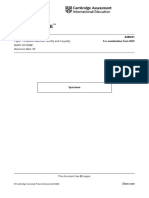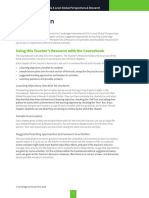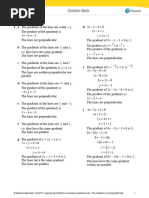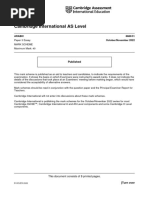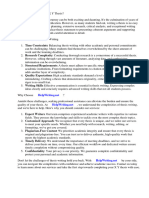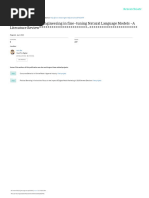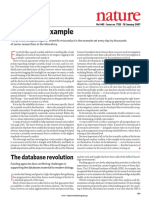Cambridge International Project
Cambridge International Project
Uploaded by
Talha NafeesCopyright:
Available Formats
Cambridge International Project
Cambridge International Project
Uploaded by
Talha NafeesOriginal Title
Copyright
Available Formats
Share this document
Did you find this document useful?
Is this content inappropriate?
Copyright:
Available Formats
Cambridge International Project
Cambridge International Project
Uploaded by
Talha NafeesCopyright:
Available Formats
Cambridge International Project Qualification
CAMBRIDGE INTERNATIONAL PROJECT 9980/01
Paper 1 Project February/March 2023
MARK SCHEME
Maximum Mark: 80
Published
This mark scheme is published as an aid to teachers and candidates, to indicate the requirements of the
examination. It shows the basis on which Examiners were instructed to award marks. It does not indicate the
details of the discussions that took place at an Examiners’ meeting before marking began, which would have
considered the acceptability of alternative answers.
Mark schemes should be read in conjunction with the question paper and the Principal Examiner Report for
Teachers.
Cambridge International will not enter into discussions about these mark schemes.
Cambridge International is publishing the mark schemes for the February/March 2023 series for most
Cambridge IGCSE™, Cambridge International A and AS Level components and some Cambridge O Level
components.
This document consists of 10 printed pages.
© UCLES 2023 [Turn over
9980/01 Cambridge IPQ – Mark Scheme February/March 2023
PUBLISHED
Generic Marking Principles
These general marking principles must be applied by all examiners when marking candidate answers.
They should be applied alongside the specific content of the mark scheme or generic level descriptors
for a question. Each question paper and mark scheme will also comply with these marking principles.
GENERIC MARKING PRINCIPLE 1:
Marks must be awarded in line with:
• the specific content of the mark scheme or the generic level descriptors for the question
• the specific skills defined in the mark scheme or in the generic level descriptors for the question
• the standard of response required by a candidate as exemplified by the standardisation scripts.
GENERIC MARKING PRINCIPLE 2:
Marks awarded are always whole marks (not half marks, or other fractions).
GENERIC MARKING PRINCIPLE 3:
Marks must be awarded positively:
• marks are awarded for correct/valid answers, as defined in the mark scheme. However, credit
is given for valid answers which go beyond the scope of the syllabus and mark scheme,
referring to your Team Leader as appropriate
• marks are awarded when candidates clearly demonstrate what they know and can do
• marks are not deducted for errors
• marks are not deducted for omissions
• answers should only be judged on the quality of spelling, punctuation and grammar when these
features are specifically assessed by the question as indicated by the mark scheme. The
meaning, however, should be unambiguous.
GENERIC MARKING PRINCIPLE 4:
Rules must be applied consistently, e.g. in situations where candidates have not followed
instructions or in the application of generic level descriptors.
GENERIC MARKING PRINCIPLE 5:
Marks should be awarded using the full range of marks defined in the mark scheme for the question
(however; the use of the full mark range may be limited according to the quality of the candidate
responses seen).
GENERIC MARKING PRINCIPLE 6:
Marks awarded are based solely on the requirements as defined in the mark scheme. Marks should
not be awarded with grade thresholds or grade descriptors in mind.
© UCLES 2023 Page 2 of 10
9980/01 Cambridge IPQ – Mark Scheme February/March 2023
PUBLISHED
Social Science-Specific Marking Principles
(for point-based marking)
1 Components using point-based marking:
• Point marking is often used to reward knowledge, understanding and application of skills.
We give credit where the candidate’s answer shows relevant knowledge, understanding
and application of skills in answering the question. We do not give credit where the answer
shows confusion.
From this it follows that we:
a DO credit answers which are worded differently from the mark scheme if they clearly
convey the same meaning (unless the mark scheme requires a specific term)
b DO credit alternative answers/examples which are not written in the mark scheme if they
are correct
c DO credit answers where candidates give more than one correct answer in one
prompt/numbered/scaffolded space where extended writing is required rather than list-type
answers. For example, questions that require n reasons (e.g. State two reasons …).
d DO NOT credit answers simply for using a ‘key term’ unless that is all that is required.
(Check for evidence it is understood and not used wrongly.)
e DO NOT credit answers which are obviously self-contradicting or trying to cover all
possibilities
f DO NOT give further credit for what is effectively repetition of a correct point already
credited unless the language itself is being tested. This applies equally to ‘mirror
statements’ (i.e. polluted/not polluted).
g DO NOT require spellings to be correct, unless this is part of the test. However spellings of
syllabus terms must allow for clear and unambiguous separation from other syllabus terms
with which they may be confused (e.g. Corrasion/Corrosion)
2 Presentation of mark scheme:
• Slashes (/) or the word ‘or’ separate alternative ways of making the same point.
• Semi colons (;) bullet points (•) or figures in brackets (1) separate different points.
• Content in the answer column in brackets is for examiner information/context to clarify the
marking but is not required to earn the mark (except Accounting syllabuses where they
indicate negative numbers).
3 Calculation questions:
• The mark scheme will show the steps in the most likely correct method(s), the mark for
each step, the correct answer(s) and the mark for each answer
• If working/explanation is considered essential for full credit, this will be indicated in the
question paper and in the mark scheme. In all other instances, the correct answer to a
calculation should be given full credit, even if no supporting working is shown.
• Where the candidate uses a valid method which is not covered by the mark scheme,
award equivalent marks for reaching equivalent stages.
• Where an answer makes use of a candidate’s own incorrect figure from previous working,
the ‘own figure rule’ applies: full marks will be given if a correct and complete method is
used. Further guidance will be included in the mark scheme where necessary and any
exceptions to this general principle will be noted.
© UCLES 2023 Page 3 of 10
9980/01 Cambridge IPQ – Mark Scheme February/March 2023
PUBLISHED
4 Annotation:
• For point marking, ticks can be used to indicate correct answers and crosses can be used
to indicate wrong answers. There is no direct relationship between ticks and marks. Ticks
have no defined meaning for levels of response marking.
• For levels of response marking, the level awarded should be annotated on the script.
• Other annotations will be used by examiners as agreed during standardisation, and the
meaning will be understood by all examiners who marked that paper.
© UCLES 2023 Page 4 of 10
9980/01 Cambridge IPQ – Mark Scheme February/March 2023
PUBLISHED
Assessment criteria
Research reports should be assessed using the criteria on the following pages.
Assessment criteria overview: Cambridge International Project Qualification
AO1 Research, Analysis and Evaluation
Research • Develop and justify an appropriate research question 24 marks
• Design and manage own project, using appropriate research
methods
• Maintain a research log to support the process of research
Analysis • Analyse findings and/or sources used in order to answer the 20 marks
research question
Evaluation • Evaluate the research methods and sources used 12 marks
AO1 Total 56 marks
AO2 Reflection
Reflection • Reflect on the strengths and limitations of the project 12 marks
• Discuss how and why personal views on the topic have
changed or developed as a result of the research conducted
AO2 Total 12 marks
AO3 Communication
Communication • Communicate clearly throughout the report, using 12 marks
appropriate subject-specific terminology, referencing and
citation techniques
• Structure the report and communicate findings clearly and in
an appropriate format
AO3 Total 12 marks
TOTAL 80 marks
© UCLES 2023 Page 5 of 10
9980/01 Cambridge IPQ – Mark Scheme February/March 2023
PUBLISHED
Assessment criteria: Cambridge International Project Qualification
AO1 Research, Analysis and Evaluation
AO1: Research
• Develop and justify an appropriate research question
• Design and manage own project, using appropriate research methods
• Maintain a research log to support the process of research
Mark
Level Indicative Descriptors
Range
4 19–24 • The question chosen has been thoughtfully justified.
• The question has clearly guided the research conducted and content of
the report.
• The research methods and/or sources used are highly appropriate for
the project and clearly justified.
• The project is very well-designed and there is evidence of careful
planning throughout.
• The research log has been consistently maintained and there is evidence
that it has been used to support the research process throughout.
3 13–18 • The question chosen has been reasonably justified.
• The question has largely guided the research conducted and content of
the report.
• The research methods and/or sources used are appropriate for the
research project and there is a reasonable justification for their selection.
• The project is well-designed and there is evidence of planning at times.
• The research log has been maintained throughout the project and there
is evidence that it has been used to support the research process at
times.
2 7–12 • There is an attempt to justify the question chosen.
• The research conducted and content of the report are broadly related to
the question.
• The research methods and/or sources used are either appropriate for the
project or there is a reasonable attempt to justify their selection.
• The project is reasonably well-designed but there is little evidence of
planning.
• The research log has been used to record information relating to some
aspects of the research process.
1 1–6 • A question has been chosen but there is no serious attempt to justify it.
• Much of the research conducted or content of the report is only vaguely
related to the question.
• At least one research method and/or a range of sources has been used
but these are not well suited to the project and there is little attempt to
justify their selection.
• The research log is superficial and gives little evidence of the research
process.
0 0 • A mark of zero should be awarded for no creditable content.
© UCLES 2023 Page 6 of 10
9980/01 Cambridge IPQ – Mark Scheme February/March 2023
PUBLISHED
AO1: Analysis
• Analyse findings and/or sources used in order to answer the research question
Mark
Level Indicative Descriptors
Range
4 16–20 • Excellent analysis of findings and/or sources used.
• The analysis is consistently focused on the research question.
• Conclusions drawn are clearly supported by the evidence presented.
• There is a clear answer in response to the research question which is
reflective of the evidence presented in the report.
3 11–15 • Good analysis of findings and/or sources used.
• The analysis is relevant to the research question.
• Conclusions drawn are supported by the evidence presented.
• There is an answer in response to the research question relevant to the
evidence presented in the report.
2 6–10 • Some analysis of findings and/or sources used.
• The analysis is partially relevant to the research question.
• Conclusions drawn are only partially supported by the evidence
presented.
• There is an answer in response to the research question but this is only
partially relevant to the evidence presented in the report.
1 1–5 • Some limited analysis of findings and/or sources used.
• The analysis lacks relevance to the research question.
• Conclusions drawn are limited or not supported by the evidence
presented.
• There is an answer in response to the research question but this is
limited or not relevant to the evidence presented in the report.
0 0 • A mark of zero should be awarded for no creditable content.
© UCLES 2023 Page 7 of 10
9980/01 Cambridge IPQ – Mark Scheme February/March 2023
PUBLISHED
AO1: Evaluation
• Evaluate the research methods and sources used
Mark
Level Indicative Descriptors
Range
4 10–12 • Detailed and insightful discussion of the strengths and limitations of the
research method(s) used.
• Explicit and effective evaluation of a range of sources.
3 7–9 • Detailed discussion of the strengths and limitations of the research
method(s) used.
• Explicit and effective evaluation of at least one source.
2 4–6 • Some discussion of the strengths and/or limitations of the research
method(s) used.
• Some explicit evaluation of a range of sources.
1 1–3 • Some limited discussion of a strength or limitations of the research
method(s) used.
• Some explicit evaluation of at least one source.
0 0 • A mark of zero should be awarded for no creditable content.
© UCLES 2023 Page 8 of 10
9980/01 Cambridge IPQ – Mark Scheme February/March 2023
PUBLISHED
AO2 Reflection
AO2: Reflection
• Reflect on the strengths and limitations of the project
• Discuss how and why personal views on the topic have changed or developed as a result of
the research conducted
Mark
Level Indicative Descriptors
Range
4 10–12 • Detailed and insightful reflection on the strengths and limitations of the
project.
• A thoughtful discussion of how and why personal views on the topic have
changed or developed, which is clearly and directly related to the
research conducted.
3 7–9 • Detailed reflection on the strengths and limitations of the project.
• A clear discussion of how and why personal views on the topic have
changed or developed, with direct reference to the research conducted.
2 4–6 • Some reflection on the strengths and/or limitations of the project.
• Some discussion of how personal views on the topic have changed or
developed, with some reference to the research conducted.
1 1–3 • Some limited reflection on a strength or limitation of the project.
• Some discussion of personal views on the topic.
0 0 • A mark of zero should be awarded for no creditable content.
© UCLES 2023 Page 9 of 10
9980/01 Cambridge IPQ – Mark Scheme February/March 2023
PUBLISHED
AO3 Communication
AO3: Communication
• Communicate clearly throughout the report, using appropriate subject-specific terminology,
referencing and citation techniques
• Structure the report and communicate findings clearly and in an appropriate format
Level Mark Indicative Descriptors
Range
4 10–12 • The report is well-structured and very clear to follow.
• A range of subject-specific terminology is used consistently and
accurately throughout the report.
• Research findings are communicated clearly and in a highly appropriate
format.
• Citation and referencing of sources are complete, consistent and in an
appropriate format.
3 7–9 • The report is well-structured and clear to follow.
• A range of mostly accurate subject-specific terminology is used
throughout the report.
• Research findings are communicated clearly and in an appropriate
format.
• Citation and referencing of sources are mostly complete and consistent
and in an appropriate format.
2 4–6 • The report is mostly well-structured and fairly clear to follow.
• Some accurate subject-specific terminology is used.
• Research findings are communicated with some clarity.
• Citation and referencing of sources are mostly complete and consistent.
1 1–3 • The report is not well-structured, making it difficult to follow.
• Some subject-specific terminology is used.
• Research findings are included.
• Citation and referencing of sources is attempted but incomplete.
0 0 • A mark of zero should be awarded for no creditable content.
© UCLES 2023 Page 10 of 10
You might also like
- 0610 Teacher Guide (For Examination From 2023)Document28 pages0610 Teacher Guide (For Examination From 2023)Ayesha TahirNo ratings yet
- Cambridge O Level: Biology 5090/42Document9 pagesCambridge O Level: Biology 5090/42afsheen24akramNo ratings yet
- Ipq-Candidate-Record-Form-And-Production-Log EditDocument23 pagesIpq-Candidate-Record-Form-And-Production-Log EditJane CarissaNo ratings yet
- Role of Intuition in Creativity: SynonymsDocument7 pagesRole of Intuition in Creativity: SynonymsYocelin Espiritu ReynosoNo ratings yet
- The KPI Institute C KPIP AustraliaDocument7 pagesThe KPI Institute C KPIP AustraliasatfasNo ratings yet
- Cambridge International Project 9980/01 March 2021Document10 pagesCambridge International Project 9980/01 March 2021Maryam ShahidNo ratings yet
- Project CambridgeDocument10 pagesProject Cambridgekaziba stephenNo ratings yet
- Cambridge International Project QualificationDocument2 pagesCambridge International Project QualificationTalha NafeesNo ratings yet
- 9980 Teacher GuideDocument24 pages9980 Teacher GuideMaryam ShahidNo ratings yet
- Proposal Form IpqDocument2 pagesProposal Form IpqsalmasapagmNo ratings yet
- IPQ - Project ProposalDocument3 pagesIPQ - Project ProposalArnav GuptaNo ratings yet
- Design and TechnologyDocument33 pagesDesign and TechnologyGivemore MuromboNo ratings yet
- Cambridge IGCSE ™: Design & Technology 0445/12Document10 pagesCambridge IGCSE ™: Design & Technology 0445/12Ali SiddiqNo ratings yet
- 2023 2025 SyllabusDocument25 pages2023 2025 SyllabusAli FetohNo ratings yet
- 2025 Specimen Paper 1 MarkschemeDocument22 pages2025 Specimen Paper 1 Markschemeernunny xcyNo ratings yet
- 9699 Specimen Paper Answers Paper 3 For Examination From 2021Document16 pages9699 Specimen Paper Answers Paper 3 For Examination From 2021Trang MinhNo ratings yet
- 9239 Teacher Guide (For Examination From 2023) - 1Document81 pages9239 Teacher Guide (For Examination From 2023) - 1baasankhuuNo ratings yet
- Learner Guide Bs A LevelDocument50 pagesLearner Guide Bs A Levelnooramaanianas100% (1)
- Cambridge International AS & A Level: Sociology 9699/22Document18 pagesCambridge International AS & A Level: Sociology 9699/22chemceptualwithfaizNo ratings yet
- 2024 Specimen Mark Scheme Paper 2Document21 pages2024 Specimen Mark Scheme Paper 2nananananannanananaNo ratings yet
- Cie As Level EnglishDocument8 pagesCie As Level EnglishbalanvbalanNo ratings yet
- Syllabus: Cambridge International Project Qualification 9980Document23 pagesSyllabus: Cambridge International Project Qualification 9980Maryam ShahidNo ratings yet
- Cambridge International AS Level: English General Paper 8021/12 May/June 2019Document13 pagesCambridge International AS Level: English General Paper 8021/12 May/June 2019Ivy AngNo ratings yet
- Cambridge IGCSE ™: Co-Ordinated Sciences 0654/41Document15 pagesCambridge IGCSE ™: Co-Ordinated Sciences 0654/41Khoa DangNo ratings yet
- Syllabus 2023Document42 pagesSyllabus 2023MarinaNo ratings yet
- 9990 Y18 SOW v3Document113 pages9990 Y18 SOW v3Priyanka Raghu100% (2)
- 2024 2026 SyllabusDocument33 pages2024 2026 SyllabusAhmad MotaizNo ratings yet
- Syllabus: Cambridge International AS & A Level Global Perspectives & Research 9239Document39 pagesSyllabus: Cambridge International AS & A Level Global Perspectives & Research 9239Sabeha KhanNo ratings yet
- PE 2022-2024-SyllabusDocument39 pagesPE 2022-2024-SyllabusNambiNo ratings yet
- 9239 04 Outline Proposal FormDocument2 pages9239 04 Outline Proposal FormbonalambokNo ratings yet
- wbs11 01 Pef 20230302Document6 pageswbs11 01 Pef 20230302uvaliyeva.atNo ratings yet
- 9093 Example Candidate Responses Paper 3 (For Examinations From 2021)Document29 pages9093 Example Candidate Responses Paper 3 (For Examinations From 2021)Sai ManognyaNo ratings yet
- 9607 Example Candidate Responses Paper 4 (For Examination From 2021)Document26 pages9607 Example Candidate Responses Paper 4 (For Examination From 2021)Soha SohailNo ratings yet
- Guidelines For The Use of The Cambridge International School LogoDocument8 pagesGuidelines For The Use of The Cambridge International School LogoSaqibNazirNo ratings yet
- 2210 - Learner - Guide - (For - Examination - From - 2023) Computer ScienceDocument27 pages2210 - Learner - Guide - (For - Examination - From - 2023) Computer ScienceNafees KhanNo ratings yet
- Cambridge IGCSE™: Spanish 0530/22 May/June 2022Document11 pagesCambridge IGCSE™: Spanish 0530/22 May/June 2022ParvNo ratings yet
- 11_0625_43_ms_prov_rma_28102024Document25 pages11_0625_43_ms_prov_rma_28102024ethansancho10No ratings yet
- Cambridge International AS Level: English General Paper 8021/13 May/June 2019Document13 pagesCambridge International AS Level: English General Paper 8021/13 May/June 2019Edwin Muronzi100% (1)
- 8682 Example Candidate Responses Paper 3 (For Examination From 2021)Document20 pages8682 Example Candidate Responses Paper 3 (For Examination From 2021)JayeN MoorghenNo ratings yet
- Cambridge O Level: Chemistry 5070/21Document11 pagesCambridge O Level: Chemistry 5070/21Pahal KalraNo ratings yet
- Cambridge IGCSE™: Physical Science 0652/31 October/November 2021Document9 pagesCambridge IGCSE™: Physical Science 0652/31 October/November 2021lewis100% (1)
- 2023 Specimen Paper 4 Mark SchemeDocument12 pages2023 Specimen Paper 4 Mark Schemel PLAY GAMESNo ratings yet
- Cambridge IGCSE ™: Travel & Tourism 0471/22Document11 pagesCambridge IGCSE ™: Travel & Tourism 0471/22minalsehrNo ratings yet
- ASAL Business TR Lesson Plan ExemplarDocument3 pagesASAL Business TR Lesson Plan ExemplarAnne VargheseNo ratings yet
- 0500 0522 Speaking and Listening Training Handbook 2013 Web PDFDocument76 pages0500 0522 Speaking and Listening Training Handbook 2013 Web PDFQuratulain Altaf HusainNo ratings yet
- 9990 Teaching Research StudiesDocument15 pages9990 Teaching Research StudiesPeter Morrison GreenerNo ratings yet
- Cambridge IGCSE™: Design & Technology 0445/13 May/June 2021Document10 pagesCambridge IGCSE™: Design & Technology 0445/13 May/June 2021Robbie TurnerNo ratings yet
- Written Exam FormatDocument2 pagesWritten Exam FormatRomessa Ali100% (1)
- 0460 Example Candidate Responses Paper 4Document34 pages0460 Example Candidate Responses Paper 4chrg5p754gNo ratings yet
- Cambridge International AS Level: English General Paper 8021/11 May/June 2021Document16 pagesCambridge International AS Level: English General Paper 8021/11 May/June 2021dontspreadaboutme100% (2)
- 2024 Onwards - 9990 AICE Psychology Student Learner GuideDocument37 pages2024 Onwards - 9990 AICE Psychology Student Learner Guidesarah gadeNo ratings yet
- Biology Learner GuideDocument51 pagesBiology Learner Guideluna.art2007No ratings yet
- 0580 Y12 Ecr P2 v2Document45 pages0580 Y12 Ecr P2 v2Kay SinghNo ratings yet
- Using This Teacher's Resource With The Coursebook: Cambridge International AS & A Level Global Perspectives & ResearchDocument2 pagesUsing This Teacher's Resource With The Coursebook: Cambridge International AS & A Level Global Perspectives & ResearchSwati RaiNo ratings yet
- Cambridge IGCSE ™: History 0470/41Document16 pagesCambridge IGCSE ™: History 0470/41Top ChuolNo ratings yet
- 03 0450 22 MS Prov Rma 20022023Document21 pages03 0450 22 MS Prov Rma 20022023abin alexanderNo ratings yet
- Vocab For Framing Lesson Objectives and OutcomesDocument1 pageVocab For Framing Lesson Objectives and OutcomesStephen MceleaveyNo ratings yet
- 8700 2 QP EnglishLanguage G 9nov23 AMDocument24 pages8700 2 QP EnglishLanguage G 9nov23 AMBXR StudiosNo ratings yet
- Syllabus: Cambridge International AS and A Level PsychologyDocument40 pagesSyllabus: Cambridge International AS and A Level PsychologyHaya EishaNo ratings yet
- W73149 International GCSE Religious Studies 4RS1 An Accessible VersionDocument7 pagesW73149 International GCSE Religious Studies 4RS1 An Accessible VersionSharma Dev100% (1)
- 0457 Scheme of Work (For Examination From 2025)Document44 pages0457 Scheme of Work (For Examination From 2025)Andrew Miller100% (1)
- Cambridge International AS & A Level: SociologyDocument18 pagesCambridge International AS & A Level: Sociologyshwetarameshiyer7No ratings yet
- Grade Thresholds - November 2018: Cambridge O Level Food and Nutrition (6065)Document1 pageGrade Thresholds - November 2018: Cambridge O Level Food and Nutrition (6065)Talha NafeesNo ratings yet
- June 2022 QP - Paper 2 Edexcel Physics a-levelDocument32 pagesJune 2022 QP - Paper 2 Edexcel Physics a-levelTalha NafeesNo ratings yet
- RR 2493 10921 30-Dec-22Document5 pagesRR 2493 10921 30-Dec-22Talha NafeesNo ratings yet
- June 2018 QP - Paper 2 Edexcel Physics a-levelDocument32 pagesJune 2018 QP - Paper 2 Edexcel Physics a-levelTalha NafeesNo ratings yet
- P1 Exercise 5FDocument5 pagesP1 Exercise 5FTalha NafeesNo ratings yet
- Updated IBA Math Main Book Answers 2022-23 (18-8-22)Document4 pagesUpdated IBA Math Main Book Answers 2022-23 (18-8-22)Talha NafeesNo ratings yet
- Cambridge International A Level: Afrikaans 9679/03 October/November 2022Document3 pagesCambridge International A Level: Afrikaans 9679/03 October/November 2022Talha NafeesNo ratings yet
- Cambridge International AS Level: Arabic 8680/31 October/November 2022Document3 pagesCambridge International AS Level: Arabic 8680/31 October/November 2022Talha NafeesNo ratings yet
- Cambridge International AS Level: Arabic Language 8680/32Document4 pagesCambridge International AS Level: Arabic Language 8680/32Talha NafeesNo ratings yet
- F AY 12091 Naia RenewDocument2 pagesF AY 12091 Naia RenewTalha NafeesNo ratings yet
- Cambridge International AS LevelDocument20 pagesCambridge International AS LevelTalha NafeesNo ratings yet
- YTML Newsletter - July-Sep'23Document41 pagesYTML Newsletter - July-Sep'23Talha NafeesNo ratings yet
- Amazing Sharm El SheikhDocument2 pagesAmazing Sharm El SheikhTalha NafeesNo ratings yet
- Denim Brochures 2Document7 pagesDenim Brochures 2Talha NafeesNo ratings yet
- Palmers by Donniedex Test 1Document21 pagesPalmers by Donniedex Test 1Alkiana SalardaNo ratings yet
- 3CO02 MadaDocument8 pages3CO02 MadaIsraelNo ratings yet
- Grade 12 STEM ResearchDocument32 pagesGrade 12 STEM ResearchTanya Miya100% (5)
- Research Methods and Experimental Design: Moving Forward in Becoming A Research UniversityDocument55 pagesResearch Methods and Experimental Design: Moving Forward in Becoming A Research UniversityJoedel LelizaNo ratings yet
- Ge8076 Professional Ethics in Engineering Lecture NotesDocument215 pagesGe8076 Professional Ethics in Engineering Lecture NotesHarini RNo ratings yet
- How Make A ThesisDocument6 pagesHow Make A Thesispamelawatkinsjackson100% (2)
- Case Study: GO-LOGISTICS Supply CandidatesDocument6 pagesCase Study: GO-LOGISTICS Supply CandidatesWendi OfficialNo ratings yet
- Kristalisasi PDFDocument28 pagesKristalisasi PDFAngga FulamdanaNo ratings yet
- Thesis Proposal Budget SampleDocument6 pagesThesis Proposal Budget Samplekatieduboseatlanta100% (2)
- Essent 1.1 PDFDocument90 pagesEssent 1.1 PDFvenkatanagachandraNo ratings yet
- X y ThesisDocument7 pagesX y ThesisPaperWritersUK100% (2)
- KFC's Vegetarian Voyage: A Consumer Insights Perspectives in Australia.Document22 pagesKFC's Vegetarian Voyage: A Consumer Insights Perspectives in Australia.aronno_du185No ratings yet
- Heran Mamo MastersDocument88 pagesHeran Mamo Mastersnatud6No ratings yet
- Methodology: 4.1 Research DesignDocument5 pagesMethodology: 4.1 Research DesignAquila Kate ReyesNo ratings yet
- IJSRED Paper SupervisedPromptEngineering ALiteratureReviewDocument9 pagesIJSRED Paper SupervisedPromptEngineering ALiteratureReviewAnusrilekha BaratamNo ratings yet
- Cherophobia 4Document8 pagesCherophobia 4CongkrekNo ratings yet
- An Assessment of Learning Difficulty Level of Math Class Topics - A Case Study of A Japanese Public Junior High SchoolDocument14 pagesAn Assessment of Learning Difficulty Level of Math Class Topics - A Case Study of A Japanese Public Junior High SchoolTJPRC PublicationsNo ratings yet
- Sample Senior Design Projects of Industrial EngineDocument9 pagesSample Senior Design Projects of Industrial Engineburlap4usaNo ratings yet
- High Rise DissertationDocument8 pagesHigh Rise DissertationWhatAreTheBestPaperWritingServicesCanada100% (1)
- ResearchPaper Makeup HUMS101A V2.3.1 chpt1-3Document14 pagesResearchPaper Makeup HUMS101A V2.3.1 chpt1-3Franco Angelo ReyesNo ratings yet
- Research Methods Course OutlineDocument4 pagesResearch Methods Course OutlineyoziscijuniorNo ratings yet
- Full Report On 2022 CG Scholarship ProgrammeDocument6 pagesFull Report On 2022 CG Scholarship Programmeproappen24No ratings yet
- Multilingual and Multicultural India: January 2008Document7 pagesMultilingual and Multicultural India: January 2008ShylajaNo ratings yet
- Thesis Topics Construction Project ManagementDocument7 pagesThesis Topics Construction Project Managementafbwrszxd100% (1)
- Group 4 FinalDocument46 pagesGroup 4 FinalTirsolito SalvadorNo ratings yet
- Warren 2006 PDFDocument29 pagesWarren 2006 PDFErika P. Muchica PizarroNo ratings yet
- Nature Magazine 7125 - 2007-01-18Document104 pagesNature Magazine 7125 - 2007-01-18Roberto KlesNo ratings yet
- Final Proposal Template 2Document4 pagesFinal Proposal Template 2Dairymple MendeNo ratings yet














